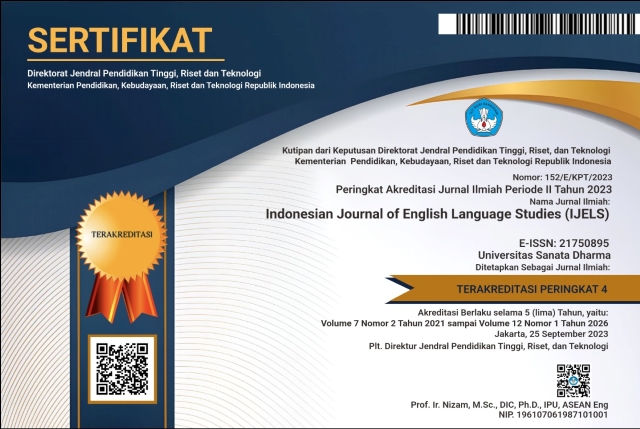The Crisscrossing of Time in Spenser’s Amoretti LXXV and Shakespeare’s Sonnet XVIII
(1) Universidade Federal de Minas Gerais, Brazil
(*) Corresponding Author
Abstract
Time is a prevalent motif in Elizabethan love sonnets, presenting itself not only as natural force to be reckoned, but also as an oppositional element in humanity’s constant search for immortality. Through the analysis of both Edmund Spenser’s Amoretti LXXV and William Shakespeare’s Sonnet XVIII I intend to explore, compare and contrast the representations of Time in their verses as well as the poets’ promises of immortality through their own writings. Drawing from Horace’s Odes and Ovid’s Metamorphoses as referential works in the discussion of Time in poetry, I will highlight how the struggle to survive the natural passage of time and its corrosive effects while having art as medium may have inspired both Spenser and Shakespeare’s efforts into building their own metonymical pieces of art. Through this work I hope to delve further into the motif of Time as a force that opposes the logic of stability and immutability often proposed by an art that promises the immortalization of one’s love interest.
Keywords
Full Text:
PDFReferences
Baroloni, T. (2009). The self in the labyrinth of time - rerum vulgarium fragmenta. In: Kirkham, V., Maggi, A. (Eds). Petrarch: A critical guide to the complete works. Chicago: The University of Chicago Press. 33-62.
Bate, J. (1993). Shakespeare and ovid. Oxford: Claredon Paperbacks.
Bellour, L. (2017). Time and immortality in William Shakespeare’s Sonnets. Makalid, 2017(13), 175-180.
Blick, F. (2008). Spenser's Amoretti and Elizabeth Boyle: Her name immortalized. Spenser Studies, 23. 309–315.
Branam, H. (2017). William Shakespeare's age. In J. Rosenblum (Ed.), The Definitive Shakespeare companion: Overviews, documents and analysis. Santa Barbara: Greenwood.
Culler, J. (2010). The closeness of close reading. ADE Bulletin, 149, 20-25. https://doi.org/10.1632/ade.149.2
Duncan-Jones, K. (2001). Shakespeare's Sonnets. London: Arden Shakespeare.
Dymphna, C. (2007). Confounded by winter: Speeding time in Shakespeare’s Sonnets IN: Schoenfeldt, M. A Companion to Shakespeare’s Sonnets. Oxford: Blackwell Publishings.
Fuller, D. (2011). The life in the sonnets. London: Continuum.
Gillespie, P. (2009, January 11). Shakespearean, Spenserian, & Petrarchan Sonnets. Poem Shape. Retrieved on May 18, 2022, from https://poemshape.wordpress.com/2009-/01/11/what-is-shakespearean-spenserian-amp-petrarchan-sonnets
Hentschell, R. (2017). Sonnet 18. In J. Rosenblum (Ed.), The Definitive Shakespeare Companion: Overviews, documents and analysis. Santa Barbara: Greenwood.
Horace. (1882). Odes 3.30. (J. Conington, Trans.). Retrieved on May 15, 2022 from http://data.perseus.org/citations/urn:cts:latinLit:phi0893.phi001.perseus-eng1:3.30
Kellogg, R. (1968). Thought's astonishment and the dark conceits of Spenser's Amoretti. in: Elliot, J. (ed) The prince of poets: Essays on Edmund Spenser. New York: New York University Press.
Kaula, D. (1963). "In War with Time": temporal perspectives in Shakespeare's Sonnets. Studies in English Literature, 3(1), 45-57. Retrieved on July, 15, 2022, from http://www.jstor.org/stable/449544
Kunin, A. (2009). Shakespeare’s preservation fantasy. PMLA, 124(1), pp.92–106. From http://www.jstor.org/stable/25614250. Accessed 12 May 2022.
Lever, J.W. (1956). The Elizabethan love Sonnet. London: Methuen, 1956.
Larsen, K.J. (1997). Edmund Spenser's Amoretti and Epithalamion: A Critical Edition. Tempe, Arizona: Medieval and Renaissance Texts and Studies, v.146.
Martz, L. (1961). The Amoretti: Most goodly temperature. In: Nelson, W. (ed). Form and Convention in the Poetry of Edmund Spenser: Selected Papers from the English Institute. New York: Columbia University Press. 146-68.
Oram, W. (2020). What happens in the Amoretti. Spenser Review, 50(2.3). Retrieved on July 20, 2022, from http://www.english.cam.ac.uk/spenseronline/review/item/50.2.3
Ovid. (2012). Metamorphoses. (I. Johnston, Trans.). (Original work published 8AD). Retrieved on May 15, 2022, from https://johnstoniatexts.x10host.com/ovid/ovidtofc.html
Pavel, T. (1978). Literary criticism and methodology. Topicos Actuales En Semiotica Literaria, 3(7/8), 145-156. Retrieved on July 15, 2022, from http://www.jstor.org/stable/41491138
Punchner, M., Akbari, S., Denecke, W., Dharwadker, V., Fuchs, B., Levine, C., Lewis, P., Wilson, W. (2012). The norton anthology of world literature: Volume C. 3rd Edition. New York: W. W. Norton & Company.
Stenner, R., Badcoe, T., Griffith, G. (Eds.) (2019). Rereading chaucer and Spenser. Dan Geffrey with the New Poete. Manchester: Manchester University Press.
Stoll, E.E. (1967). Poets and playwrights: Shakespeare, Jonson, Spenser, Milton. Mineapolis: University of Minnesota Press.
Vendler, H. (1997). The Art of Shakespeare's Sonnets. Cambridge, Mass: Belknap Press of Harvard University Press.
Wilder, L. P.. (2019). Reserved character: Shorthand and the immortality topos in Shakespeare’s Sonnets. Studies in Philology, 116(3), 478–505, Retrieved on May 11, 2022, from https://www.jstor.org/stable/26695107
DOI: https://doi.org/10.24071/ijels.v8i2.4911
Refbacks
- There are currently no refbacks.

This work is licensed under a Creative Commons Attribution-ShareAlike 4.0 International License.
IJELS Journal Sinta 4 Certificate (S4 = Level 4)
We would like to inform you that Indonesian Journal of English Language Studies (IJELS) has been nationally accredited Sinta 4 by the Ministry of Education, Culture, Research and Technology of the Republic of Indonesia based on the decree No. Surat Keputusan 152/E/KPT/2023. Validity for 5 years: Vol 7 No 2, 2021 till Vol 12 No 1, 2026

This work is licensed under CC BY-SA.
Creative Commons Attribution-ShareAlike 4.0 International License
IJELS e-ISSN 2715-0895; IJELS p-ISSN 2442-790X
Indonesian Journal of English Language Studies (IJELS) is published twice a year, namely in March and September, by the English Language Studies (ELS) of the Graduate Program of Sanata Dharma University, Yogyakarta, Indonesia.


 IJELS p-ISSN:
IJELS p-ISSN: 










